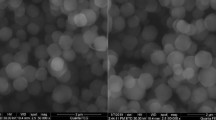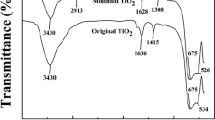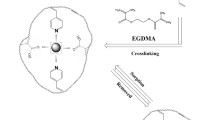Abstract
Water solution polymerization was adopted to prepare perrhenate ion imprinted polymers in this work, and preparation conditions, such as molar ratio of acrylic acid, N,N - methylene double acrylamide, hydrogen peroxide and ascorbic acid to N-vinyl pyrrolidone, polymerization time and temperature on adsorption separation property were investigated and optimized using adsorption quantities and separation degree as indexes. To enhance the adsorption selectivity, adsorption properties of samples prepared under different conditions were conducted in a mixture aqueous solution of ammonium perrhenate and potassium permanganate with the molar ratio of 1:1. Results showed that as the molar ratio of N,N - methylene double acrylamide, acrylic acid, hydrogen peroxide, ascorbic acid to N-vinyl pyrrolidone were 2.0, 1.9, 0.03, and 0.003 respectively, the reaction temperature and time were 35 °C and 24 h, adsorption quantities and separation degree arrived at 0.037 mmol/g and 2.31, respectively, while the adsorption capacities and separation degree of non-imprinted polymers were only 0.009 mmol/g and 0.22. Besides, study was also discovered that the prepared samples presented an exciting reusable stability. Based on samples prepared under optimal conditions, the structure was characterized by Fourier transform infrared spectroscopy, scanning electron microscope, transmission electron microscope, BET surface area and thermogravimetric analysis using non-imprinted polymer prepared under the same conditions as a control. Finally, the adsorption thermodynamics and kinetics were studied, and the kinetics documented that the adsorption of perrhenate ion imprinted polymers was a zero-order model process. The thermodynamics presented the adsorption was more suitable to be expressed by Langmuir model, and Scatchard analysis revealed that heterogeneous binding sites were formed in IIP.






Similar content being viewed by others
References
Guo JM, He XT, Wang H, Wu XL, Zhao Y (2012) Reviews of metallurgical technology to recovery platinum group metals from secondary resource in China. Precious Metal 33:18–23
Xin Z, Bai R, Wang D, Cai X, Feng W, Xia M, Yu J (2011) Research development of refractory metal materials used in the field of aerospace. Rare Metal Mat Eng 40:1871–1875
Liu LF, Wu SS, Chen Y, Lv SL (2016) Oxidation behavior of RE-modified nickel-based superalloy between 950° C and 1150° C in air. Trans. Nonferrous Met Soc China 26:1163–1169
Li H, He X, Zhao Y (2014) Resources, application and extraction status of rhenium. Precious Metals 2:77–81
Fleischmann E, Miller MK, Affeldt E, Glatzel U (2015) Quantitative experimental determination of the solid solution hardening potential of rhenium, tungsten and molybdenum in single-crystal nickel-based superalloys. Acta Mater 87:350–356
Chen X, Tan Z, Wu YF, Liu B, Guo ZJ, Li RB (2017) Recent progress of recovery of scattered metal rhenium from high-temperature alloy scrap. Mod Chem Ind 37:60–63
Rathkopf C, Mazdab F, Barton I, Barton MD (2017) Grain-scale and deposit-scale heterogeneity of re distribution in molybdenite at the Bagdad porphyry cu-Mo deposit. Arizona J Geochem Explor 178:45–54
Abdollahi H, Noaparast M, Shafaei SZ, Manafi Z (2015) Acidic leaching with chlorate as oxidizing agent to extract Mo and re from molybdenite flotation concentrate in a copper plant. Sep Sci Technol 50:2396–2404
Fang DW, Song ZR, Zhang SC, Li J, Zang SL (2017) Solvent extraction of rhenium(VII) from aqueous solution assisted by hydrophobic ionic liquid. J Chem Eng Data 62:1094–1098
Zang SL, Zhao GS, Zhao HM, Li J, Fang DW (2016) Thermodynamics study of rhenium solvent extraction process from sulfuric acid medium. J Chem Eng Data 61:1592–1596
Srivastava RR, Kim MS, Lee JC (2016) A novel aqueous processing of the reverted turbine-blade Superalloy for rhenium recovery. Ind Eng Chem Res 55:8191–8199
Sadrnezhaad SK, Alamdari EK (2001) Thermodynamics of extraction of ReO4− from aqueous sulfuric acid media with tri-n-butyl phosphate dissolved in kerosene. Metallurgical & Materials Transactions A 32:5–10
Ansari S, Karimi M (2017) Novel developments and trends of analytical methods for drug analysis in biological and environmental samples by molecularly imprinted polymers. Trac-Trends Anal Chem 89:146–162
Zhang W, Yun M, Yu Z, Dan C, Xiao L (2019) A novel cu (II) ion-imprinted alginate-chitosan complex adsorbent for selective separation of cu (II) from aqueous solution. Polym Bull 76:1861–1876
Min L, Feng C, Li M, Zeng Q, Qiang G (2015) Synthesis and application of a surface-grafted in (III) ion-imprinted polymer for selective separation and pre-concentration of indium (III) ion from aqueous solution. Hydrometallurgy 154:63–71
Zhu F, Li L, Xing J (2017) Selective adsorption behavior of cd (II) ion imprinted polymers synthesized by microwave-assisted inverse emulsion polymerization: adsorption performance and mechanism. J Hazard Mater 321:103–110
Ebrahimzadeh H, Asgharinezhad AA, Jalilian N, Panjali Z (2015) A simple and fast method based on new magnetic ion imprinted polymer nanoparticles for the selective extraction of Ni(II) ions in different food samples. RSC Adv 5:45510–45519
Lu J, Wu Y, Lin X, Gao J, Dong H, Chen L, Qin Y, Wang L, Yan Y (2018) Anti-fouling and thermosensitive ion-imprinted nanocomposite membranes based on grapheme oxide and silicon dioxide for selectively separating europium ions. J Hazard Mater 353:244–253
Zeng J, Lv C, Liu G, Zhang Z, Dong Z, Liu J, Wang Y (2019) A novel ion-imprinted membrane induced by amphiphilic block copolymer for selective separation of Pt (IV) from aqueous solutions. J Membr Sci 572:428–441
Cui J, Zhou Z, Xie A, Liu S, Wang Q, Wu Y, Yan Y, Li C (2019) Facile synthesis of degradable CA/CS imprinted membrane by hydrolysis polymerization for effective separation and recovery of Li+. Carbohydr Polym 205:492–499
Gui R, Jin H, Guo H, Wang Z (2018) Recent advances and future prospects in molecularly imprinted polymers-based electrochemical biosensors. Biosens Bioelectron 100:56–70
Zhu X, Zeng Y, Zhang Z, Yang Y, Zhai Y, Wang H, Liu L, Hu J, Li L (2018) A new composite of graphene and molecularly imprinted polymer based on ionic liquids as functional monomer and cross-linker for electrochemical sensing 6-benzylaminopurine. Biosens Bioelectron 108:38–45
Bagheri H, Shirzadmehr A, Rezaei M, Khoshsafar H (2018) Determination of tramadol in pharmaceutical products and biological samples using a new nanocomposite carbon paste sensor based on decorated nanographene/tramadol-imprinted polymer nanoparticles/ionic liquid. Ionics 24(3):833–843
Ahmed MA, Abdelbar NM, Mohamed AA (2018) Molecular imprinted chitosanTiO2 nanocomposite for the selective removal of rose Bengal from wastewater. Int J Biol Macromol 107:1046–1053
de León-Martínez LD, Rodríguez-Aguilar M, Ocampo-Pérez R, Gutiérrez-Hernández JM, Díaz-Barriga F, Batres-Esquivel L, Flores-Ramírez R (2018) Synthesis and. Evaluation of a Molecularly Imprinted Polymer for the Determination of Metronidazole in Water Samples 100(3):1–7
Lins SS, Virgens CF, dos Santos WNL, Estevam IHS, Brandão GC (2019) On-line solid phase extraction system using an ion imprinted polymer based on dithizone chelating for selective preconcentration and determination of mercury (II) in natural waters by CV AFS. Microchem J 150:104075
Fang L, Min X, Kang R, Yu HY, Pavlostathis SG, Luo XB (2018) Development of an anion imprinted polymer for high and selective removal of arsenite from wastewater. Sci Total Environ 639:110–117
Zarezade V, Behbahani M, Omidi F, Abandansari HS, Hesam G (2016) A new magnetic tailor made polymer for separation and trace determination of cadmium ions by flame atomic absorption spectrophotometry. RSC Adv 6(105):103499–103507
Kakavandi MG, Behbahani M, Omidi F, Hesam G (2017) Application of ultrasonic assisted-dispersive solid phase extraction based on ion-imprinted polymer nanoparticles for preconcentration and trace determination of lead ions in food and water samples. Food Anal Methods 10(7):2454–2466
Behbahani M, Salarian M, Bagheri A, Tabani H, Omidi F, Fakhari A (2014) Synthesis, characterization and analytical application of Zn(II)-imprinted polymer as an efficient solid-phase extraction technique for trace determination of zinc ions in food samples. Journal of Food Composition & Analysis 34(1):81–89
Behbahani M, Barati M, Bojdi MK, Pourali AR, Bagheri A, Tapeh NA (2013) A nanosized cadmium(II)-imprinted polymer for use in selective trace determination of cadmium in complex matrices. Mikrochimica Acta 180(11):1117–1125
Ebrahimzadeh H, Behbahani M, Yamini Y, Adlnasab L, Asgharinezhad AA (2013) Optimization of cu(II)-ion imprinted nanoparticles for trace monitoring of copper in water and fish samples using a box–Behnken design. Reactive & Functional Polymers 73(1):23–29
Ji WH, Sun RH, Geng YL, Liu W, Wang X (2018) Rapid, low temperature synthesis of molecularly imprinted covalent organic frameworks for the highly selective extraction of cyano pyrethroids from plant samples. Anal Chim Acta 1001:179–188
Parvizi S, Behbahani M, Esrafili A (2018) Preconcentration and ultra-trace determination of hexavalent chromium ions using tailor-made polymer nanoparticles coupled with graphite furnace atomic absorption spectrometry: ultrasonic assisted-dispersive solid-phase extraction. New J Chem 42(12):10357–10365
Behbahani M, Omidi F, Kakavandi MG, Hesam G (2017) Selective and sensitive determination of silver ions at trace levels based on ultrasonic-assisted dispersive solid-phase extraction using ion-imprinted polymer nanoparticles. Appl Organomet Chem 31(11):3758
Ghorbani-Kalhor E, Behbahani M, Abolhasani J (2015) Application of ion-imprinted polymer nanoparticles for selective trace determination of palladium ions in food and environmental samples with the aid of experimental design methodology[J]. Food Anal Methods 8(7):1746–1757
Behbahani M, Hassanlou PG, Amini MM, Moazami HR, Abandansari HS, Bagheri A, Zadeh SH (2015) Selective solid-phase extraction and trace monitoring of Lead ions in food and water samples using new Lead-imprinted polymer nanoparticles. Food Anal Methods 5(8):558–568
Ghorbani-Kalhor E, Behbahani M, Abolhasani J, Hosseinzadeh KR (2015) Synthesis and characterization of modified multiwall carbon nanotubes with poly (N-Phenylethanolamine) and their application for removal and trace detection of Lead ions in food and environmental samples[J]. Food Anal Methods 8(5):1326–1334
Bitas D, Samanidou V (2018) Molecularly imprinted polymers as extracting media for the chromatographic determination of antibiotics in milk. Molecules 23(2):316
Paul PK, Treetong A, Suedee R (2017) Biomimetic insulin-imprinted polymer nanoparticles as a potential oral drug delivery system. Acta Pharma 67(2):149–168
Gao B, Du J, Zhang Y (2013) Preparation of arsenate anion surface-imprinted material IIP-PDMC/SiO2 and study on its ion recognition property. Ind Eng Chem Res 52:7651–7659
Zhou Z, Kong D, Zhu H (2018) Preparation and adsorption characteristics of an ion-imprinted polymer for fast removal of Ni(II) ions from aqueous solution. J Hazard Mater 341:355–364
Alizadeh T, Atayi K (2018) Synthesis of hydrogen phosphate anion-imprinted polymer via emulsion polymerization and its use as the recognition element of graphene/graphite paste potentiometric electrode. Materials Chemistry & Physics 209:180–187
Zhai Y, Yang D, Chang X, Liu Y, He Q (2015) Selective enrichment of trace copper(II) from biological and natural water samples by SPE using ion-imprinted polymer. J Sep Sci 31:1195–1200
Huang K, Li B, Zhou F, Mei S, Zhou Y, Jing T (2016) Selective solid-phase extraction of lead ions in water samples using three-dimensional ion-imprinted polymers. Anal Chem 88:6820–6826
Kong D, Wang N, Ning Q, Qi W, Zhuo W, Zhou Z, Ren Z (2017) Facile preparation of ion-imprinted chitosan microspheres enwrapping Fe3O4 and graphene oxide by inverse suspension crosslinking for highly selective removal of copper (II). ACS Sustain Chem Eng 5:7401–7409
Daoud AM, Zhao Y, Elkak A, Falcimaigne-Cordin A, Haupt K (2017) Enzyme-initiated free-radical polymerization of molecularly imprinted polymer Nanogels on a solid phase with an immobilized radical source. Angew Chem 129:3387–3391
Zhou T, Ding L, Che G, Jiang W, Sang L (2019) Recent advances and trends of molecularly imprinted polymers for specific recognition in aqueous matrix: preparation and application in sample pretreatment. Trac-Trends Anal Chem 114:11–28
Zhao Y, Chen Z, Li J, Liu Z, Liu D, Li Z (2017) Preparative separation and purification of flavonoids from Lamiophlomis rotata (Benth) Kudo Pigm Resin Technol 46:496–506
Zhao Y, Chen Z, Liu D, Long J, Di D (2017) Separation of flavonoids in the leaves of Sophora japonica by macroporous adsorption resin mixed-bed technology. Pigm Resin Technol 46:235–243
Deng GC, Teng HH, Zhang YY, Zhao LY, Wei M, Wang YJ, Zang SL (2006) Spectrophotometric determination of trace rhenium in molybdenum samples using the system of ReO4--ethyl violet-polyvinyl alcohol. Metal Anal 26:27–29
Fang P, Xia W, Zhou Y, Ai Z, Yin W, Xia M, Yue Q (2020) Ion-imprinted mesoporous silica/magnetic graphene oxide composites functionalized with Schiff-base for selective cu(II) capture and simultaneously being transformed as a robust heterogeneous catalyst. Chem Eng J 6:10
Samah NA, Rosli NAM, Manap AHA, Aziz YFA, Yusoff MM (2020) Synthesis & characterization of ion imprinted polymer for arsenic removal from water: a value addition to the groundwater resources. Chem Eng J 394:124900
Wang Y, Zhou J, Zhang B, Tian L, Ali Z, Zhang Q (2017) Fabrication and characterization of glutathione-imprinted polymers on fibrous SiO2 microspheres with high specific surface. Chem Eng J 327:932–940
Tanodekaew S, Prasitsilp M, Swasdison S, Thavornyutikarn B, Pothsree T, Pateepasen R (2004) Preparation of acrylic grafted chitin for wound dressing application. Biomaterials 25(7):1453–1460
Thurmer MB, Diehl CE, Brum FJ, Santos LA (2014) Preparation and characterization of hydrogels with potential for use as biomaterials. Materials Research-ibero-american Journal of Materials:109–113
Lin C, Lee C, Chiu W (2005) Preparation and properties of poly(acrylic acid) oligomer stabilized superparamagnetic ferrofluid. J Colloid Interface Sci 291(2):411–420
Moharram MA, Allam MA (2007) Study of the interaction of poly(acrylic acid) and poly(acrylic acid-poly acrylamide) complex with bone powders and hydroxyapatite by using TGA and DSC. J Appl Polym Sci 105(6):3220–3227
Han HL (2019) Study on Thermolysis of ammonium Perrhenate and application on silver catalyst. Journal of Qilu University of Technology 33(03):35–38
Nakhjiri MT, Marandi GB, Kurdtabar M (2018) Poly(AA-co-VPA) hydrogel cross-linked with N -maleyl chitosan as dye adsorbent: isotherms, kinetics and thermodynamic investigation. Int J Biol Macromol 117:152–166
Blackmond DG (2005) Reaction progress kinetic analysis: a powerful methodology for mechanistic studies of complex catalytic reactions. Angew Chem-Int Edit 44:4302–4320
Valderrama C, Cortina J, Farran A, Gamisans X, de Las HF (2008) Kinetic study of acid red “dye” removal by activated carbon and hyper-cross-linked polymeric sorbents macronet Hypersol MN200 and MN300. React Funct Polym 68:718–731
Mergola L, Scorrano S, Bloise E, Di Bello MP, Catalano M, Vasapollo G, Del Sole R (2016) Novel polymeric sorbents based on imprinted hg (II)-diphenylcarbazone complexes for mercury removal from drinking water. Polym J 48:73–79
Matsui J, Miyoshi Y, Doblhoff-Dier O, Takeuchi T (1995) A molecularly imprinted synthetic polymer receptor selective for atrazine. Anal Chem 67:4404–4408
Niu Y, Qu R, Chen H, Mu L, Liu X, Wang T, Zhang Y, Sun C (2014) Synthesis of silica gel supported salicylaldehyde modified PAMAM dendrimers for the effective removal of hg (II) from aqueous solution. J Hazard Mater 278:267–278
Liu Y, Xu L, Liu J, Liu X, Chen C, Li G, Meng Y (2016) Graphene oxides cross-linked with hyperbranched polyethylenimines: preparation, characterization and their potential as recyclable and highly efficient adsorption materials for lead (II) ions. Chem Eng J 285:698–708
Guo B, Deng F, Zhao Y, Luo X, Luo S, Au C (2014) Magnetic ion-imprinted and-SH functionalized polymer for selective removal of Pb (II) from aqueous samples. Appl Surf Sci 292:438–446
Acknowledgments
This work was supported by Joint fund between Shenyang National Laboratory for Materials Science and State Key Laboratory of Advanced Processing and Recycling of Nonferrous Metals. (18LHZD003;18LHPY004) and Open Project of State Key Laboratory of Nickel and Cobalt Resources Comprehensive Utilization (2019-16).
Author information
Authors and Affiliations
Corresponding authors
Ethics declarations
Competing interests
The author(s) declare no competing interests.
Additional information
Publisher’s note
Springer Nature remains neutral with regard to jurisdictional claims in published maps and institutional affiliations.
Electronic supplementary material
ESM 1
(DOCX 1349 kb)
Rights and permissions
About this article
Cite this article
Zhang, X., Jia, W., Li, D. et al. Study on synthesis and adsorption properties of ReO4− ion imprinted polymer. J Polym Res 27, 201 (2020). https://doi.org/10.1007/s10965-020-02172-8
Received:
Accepted:
Published:
DOI: https://doi.org/10.1007/s10965-020-02172-8




